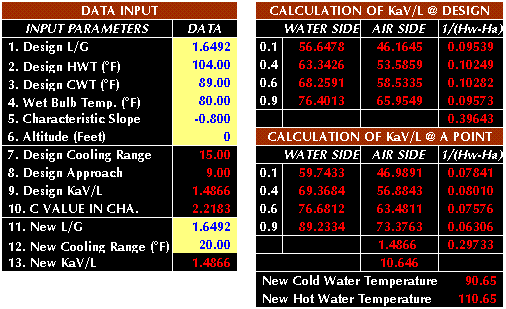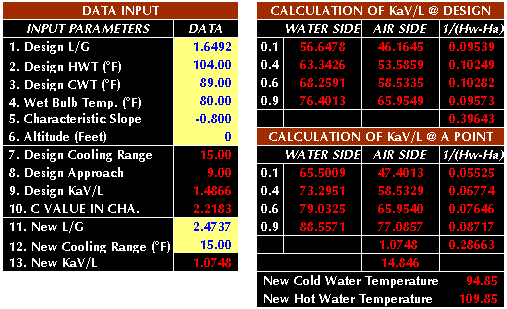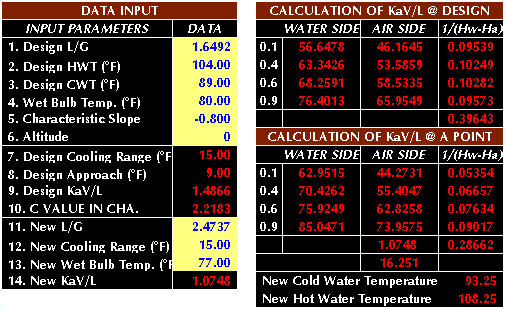| (Solution)
Range, R1 = HWT - CWT = tw2 -
tw1 = 104 - 89 = 15oF
Water Flow Rate in Pound, L1 = L2
= Water Flow Rate x (500 / 60) = 16,000 x (500 / 60)
= 133,333.3 lb/min
Air Mass Flow Rate, G1 = G2 =
80,848 lb/min
Liquid to Gas Ratio, L/G1 = L1
/ G1 = L/G2 = 133,333.3 / 80,848
= 1.6492
Range, R2 = 20oF
The value of NTU, and "C" at the design conditions
is same as a value calculated in the example 4-1. Also,
the new tower characteristic for even a increased cooling
range is same as the example 4-1. Iterate until the
value of new characteristic is equal to the new NTU
varying the value of approach. (New Cold Water Temperature
= Wet Bulb Temperature + New Approach)

Fifth Step: Compute
the cold water temperature with the result of iteration
as follows;
New CWT = WBT + New Approach
= 80 + 10.65 = 90.65oF
New HWT = CWT + Range = 90.65 + 20 = 110.65oF
Example 4-5. Assume
the existing mechanical-draft cooling tower is operating
at the initial conditions of example 4-1. Determine
the cold & hot water temperature if the air mass
flow rate is reduced to 53,900 lb/min by the adjustment
of the fan pitch angle and/or fan speed.
(Solution)
Range, R1 = HWT - CWT = tw2 -
tw1 = 104 - 89 = 15oF
Water Flow Rate in Pound, L1 = L2
= Water Flow Rate x (500 / 60) = 16,000 x (500 / 60)
= 133,333.3 lb/min
Air Mass Flow Rate, G1 = 80,848 lb/min
Liquid to Gas Ratio, L/G1 = L1
/ G1 = 133,333.3 / 80,848 = 1.6492
Air Mass Flow Rate, G2 = 53,900 lb/min
Liquid to Gas Ratio, L/G2 = L2
/ G2 = 133,333.3 / 53,900 = 2.4737
The value of NTU, and "C"
at the design conditions is same as a value calculated
in the example 4-1.Calculate a new tower characteristic
for the decreased air mass flow.
New Tower Characteristic
= C x (L/G)-m = 2.21825 x (2.4737)-0.8
= 1.0748
Iterate until the value of new characteristic is equal
to the new NTU varying the value of approach. New Cold
Water Temperature = Wet Bulb Temperature + New Approach

Fifth Step: Compute
the cold water temperature with the result of iteration
as follows;
New CWT = WBT + New Approach
= 80 + 14.85 = 94.85oF
New HWT = CWT + Range = 94.85 + 15 = 109.85oF
Example 4-6. Assume
that the cold & hot water temperature at the conditions
where the wet bulb temperature is decreased to 77oF
from 80oF and the air mass flow is changed
to 53,900 lb/min. Others remain unchanged from example
4-1.
(Solution)
Range, R1 = R2 = HWT - CWT = tw2
- tw1 = 104 - 89 = 15oF
Water Flow Rate in Pound, L1 = Water Flow
Rate x (500 / 60) = 16,000 x (500 / 60) = 133,333.3
lb/min
Air Mass Flow Rate, G1 = 80,848 lb/min
Liquid to Gas Ratio, L/G1 = L1
/ G1 = L2 = 133,333.3 / 80,848
= 1.6492
Air Mass Flow Rate, G2 = 53,900 lb/min
Liquid to Gas Ratio, L/G2 = L2
/ G2 = 133,333.3 / 53,900 = 2.4737
The value of NTU, and "C"
at the design conditions is same as a value calculated
in the example 4-1. Calculate a new tower characteristic
for the decreased air mass flow.
New Tower Characteristic
= C x (L/G)-m = 2.21825 x (2.4737)-0.8
= 1.0748
Forth Step: Iterate
until the value of new characteristic is equal to the
new NTU varying the value of approach. New Cold Water
Temperature = Wet Bulb Temperature + New Approach

Fifth Step:
Compute the cold water temperature with the result of
iteration as follows;
New CWT = WBT
+ New Approach = 77.0 + 16.25 = 93.25oF
New HWT = CWT + Range = 93.25 + 15 = 108.25oF
Download the
example file(exe4_6.zip) |